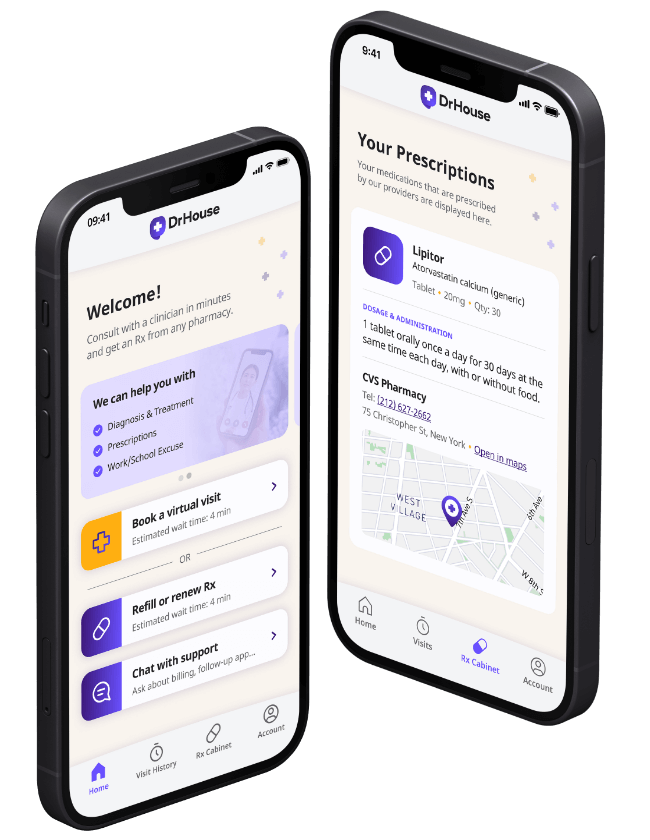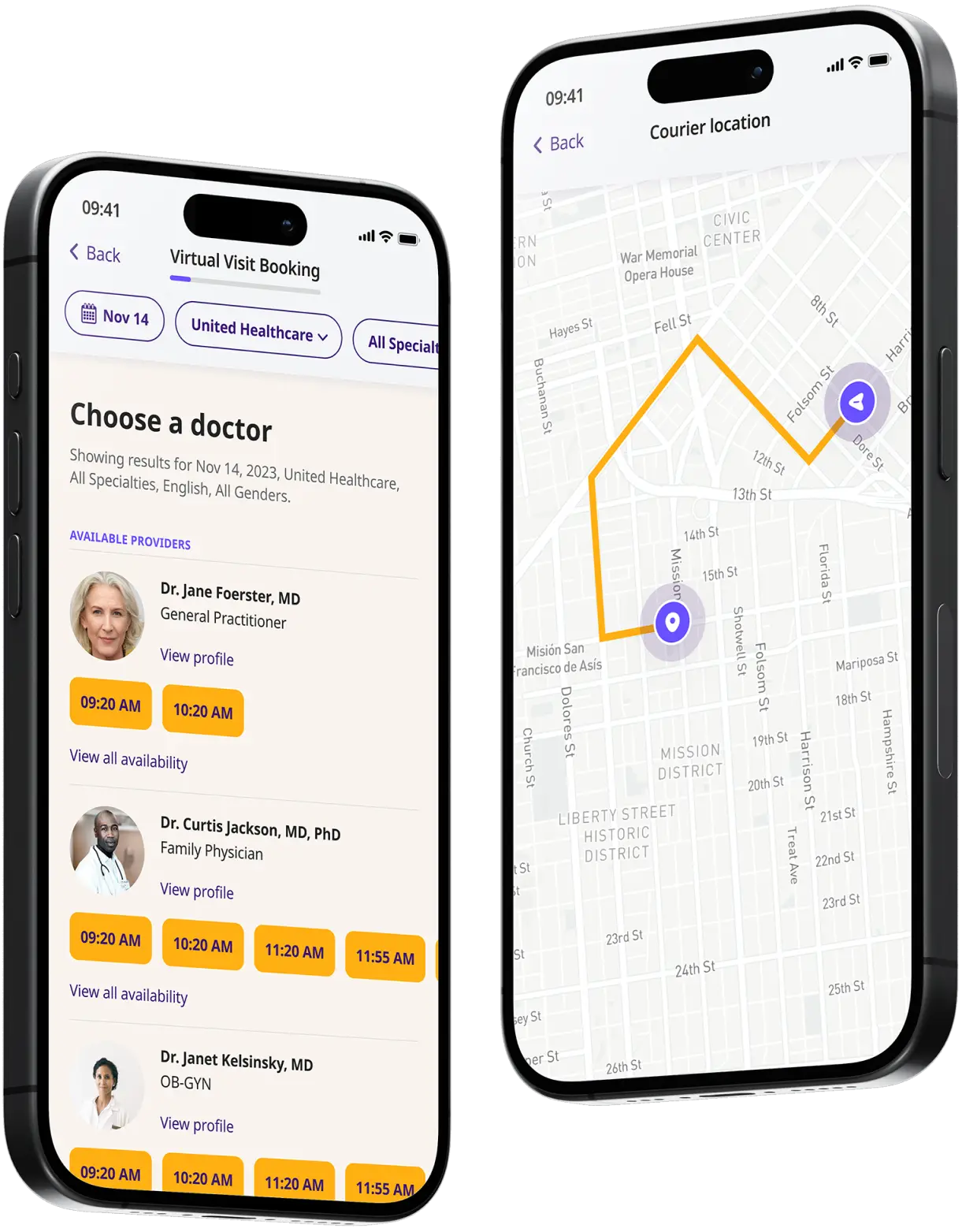Treatment for Skin Infections Online
Get expert online care for skin infections. DrHouse provides fast diagnosis and treatment for redness, swelling, and pain.


Available in 50 states. Insurance accepted.
Fast
virtual visits
24/7 care
assistants
Prescriptions
as needed

24/7 Personal Care
Consult with a physician in 15 minutes, refill an Rx or chat with our care assistants.

Affordable & Convenient
See your cost upfront and get treatment for hundreds of different conditions.

Insurance Accepted
We accept most major insurance plans, making healthcare easy and affordable.
See If Delivery Is Available Near You
Delivery Not Available
Enter your ZIP code to check if prescription delivery is available in your area and how soon your meds could arrive.
How to get started
Choose your doctor, start a virtual visit, and have your prescriptions sent to your preferred pharmacy for pickup — all in just a few easy steps.
Choose a doctor
Choose a physician by availability, specialty, ratings, and more.

Start your video visit
Connect with a doctor in minutes on a secure video call.

Get your prescription
Pick up your meds or have them delivered in as little as an hour.

Available in 50 states. Insurance accepted.
One-Time
Physician Visit
One-time visit with a physician for diagnosis, treatment, Rx, labs, referrals, and doctor’s notes.
Accepted Insurances
See why people turn to DrHouse...
As seen in

Skin Infection Treatment Online
What is a skin infection?
A skin infection occurs when pathogens such as bacteria, viruses, fungi, or parasites invade the skin and sometimes the deep tissues beneath it. The infection typically starts when these microorganisms penetrate the skin’s protective barrier, which can happen through cuts, scrapes, bites, or other breaks in the skin.
Depending on the type of pathogen, the severity and symptoms of skin infections can vary significantly.
Skin infections are a common health issue and can range from mild to severe, sometimes requiring medical attention. They can appear anywhere on the body and can cause a variety of symptoms, including redness, swelling, pain, and itching. Some infections might also lead to blisters, sores, and, in severe cases, systemic symptoms like fever.
The skin is the body’s first line of defense against infectious agents. When this barrier is compromised, not only can local infections occur, but the risk of systemic spread increases. Proper diagnosis and treatment are crucial to manage the infection effectively and prevent further complications.
Types of skin infections
Skin infections can be classified into four main types based on the causative organisms: bacterial, fungal, viral, and parasitic. Each type has distinctive characteristics and commonly associated conditions.
- Bacterial skin infections: These are caused by various types of bacteria, including Staphylococcus aureus and Streptococcus pyogenes. Bacterial skin infections can occur anywhere on the body but are most common in areas that are frequently exposed to bacteria, such as the face, hands, feet, and groin.
- Fungal skin infections: Fungi are organisms that thrive in warm, moist environments. They can cause a variety of skin infections, including ringworm, athlete’s foot, and yeast infections. These types of infections are more common in people who live in humid climates or have weakened immune systems.
- Viral skin infections: Viruses can also cause skin infections, such as warts, herpes simplex virus (HSV), chickenpox, and shingles. These viruses are highly contagious and can spread easily through direct contact or through contaminated objects.
- Parasitic skin infections: Parasites like mites, lice, and ticks can also infest the skin and cause irritation and infection. Scabies is a common parasitic infection that causes intense itching and a rash on the skin.
Common skin infections
Skin infections are a prevalent health concern that affects millions of people worldwide. They can arise from a variety of causative agents, including bacteria, viruses, fungi, and parasites.
Each type of infection not only presents unique symptoms but also requires different treatment approaches. Here are some common skin infections:
- Impetigo: Impetigo is a highly contagious bacterial infection primarily affecting children, although it can occur in adults. It is often caused by Staphylococcus aureus or Streptococcus pyogenes. This infection is characterized by red sores that pop easily, forming a honey-colored crust. Typically, impetigo appears around the mouth, nose, and extremities.
- Cellulitis: Cellulitis is a common and potentially serious bacterial skin infection that appears as a swollen, red area that is hot and tender to the touch, often on the lower legs. It can spread rapidly, affecting deeper tissues and entering the lymph nodes and bloodstream.
- Athlete’s Foot (tinea pedis): Athlete’s foot, caused by fungi, is an infection that starts between the toes and can spread to other parts of the foot. It’s associated with itching, stinging, and burning sensations, and is common among individuals who frequent communal showers and swimming pools.
- Ringworm (Tinea Corporis): Contrary to its name, ringworm is not caused by a worm but by a fungus. It appears as a flat, round patch on the skin, often with a scaly, red border. Ringworm can affect both humans and animals and is highly contagious.
- Shingles (herpes zoster): Shingles is caused by the reactivation of the varicella-zoster virus, the same virus that causes chickenpox. It is characterized by a painful rash that may appear as a stripe of blisters on one side of the body or face. The risk increases with age, especially in individuals over 50 or those with weakened immune systems.
- Scabies: Scabies is an infestation of the skin by the mite Sarcoptes scabiei. The mites burrow into the skin to live and lay eggs, causing intense itching and a pimple-like rash. Scabies spreads quickly in crowded environments and through close physical contact.
- Psoriasis: Though not infectious, psoriasis is a common skin condition that speeds up the life cycle of skin cells, causing cells to build up rapidly on the surface of the skin. The extra skin cells form scales and red patches that are itchy and sometimes painful.
- Eczema (atopic dermatitis): Eczema is a condition that causes inflamed, itchy, cracked, and rough patches of skin. It’s more common in children but can occur at any age. Eczema may be triggered by environmental factors or allergens.
- Hives (urticaria): Hives are a reaction that appears as a sudden outbreak of swollen, red bumps or welts on the skin. They can be triggered by allergies, stress, or unknown reasons.
- Warts: Caused by the human papillomavirus (HPV), warts are growths on the skin that are usually harmless and appear most often on the hands and feet. They can be contagious, spreading through physical contact with the wart.
Skin infection symptoms
Here are some common symptoms associated with different types of skin infections:
- Redness: Often one of the first signs of a skin infection, the affected area may appear red and swollen.
- Swelling: Infections often lead to inflammation, causing the skin to swell.
- Pain or tenderness: The affected area may be painful to touch or spontaneously painful.
- Warmth: The infected area might feel warm or hot to the touch, indicating inflammation and increased blood flow.
- Itching: Many skin infections cause severe itching, which can lead to scratching and further damage to the skin.
- Rash: Rashes are a common symptom of fungal, viral, and parasitic skin infections, and they vary in appearance depending on the infection.
More specific symptoms by infection type include:
- Blisters or sores: Viral infections like herpes simplex can cause fluid-filled blisters that burst and crust over.
- Pus or discharge: Bacterial infections, such as impetigo, often produce pus or a yellowish crust.
- Peeling or flaky skin: Fungal infections like athlete’s foot can cause the skin to peel or flake off.
- Ulcers: Some bacterial infections can progress to painful ulcers, which are open sores on the skin or mucous membranes.
- Scaling: Ringworm, a fungal infection, leads to ring-like patches on the skin with a distinct scaly border.
- Darkened skin: Some bacterial and fungal infections can cause the skin to darken in the infected area.
In more severe cases, a skin infection can lead to systemic symptoms, which suggest the infection might be spreading beyond the skin:
- Fever: A high temperature might accompany an infection, especially if it is spreading or becoming more severe.
- Fatigue: General feelings of tiredness or weakness may occur.
- Chills: Often accompany a fever and suggest the body is fighting off a more severe infection.
- Swollen lymph nodes: Nearby lymph nodes may swell in response to the infection as part of the immune response.
Skin infection risk factors
Here’s an overview of the common risk factors that can increase the likelihood of developing a skin infection:
- Broken skin: Cuts, scrapes, punctures, or any breach in the skin’s integrity can provide an entry point for pathogens. This is the most direct and common risk factor for bacterial, fungal, and viral skin infections.
- Contact with contaminated surfaces or infected individuals: Skin infections can spread through direct contact with infected individuals or indirectly by touching surfaces that harbor pathogens. Places like gyms, communal showers, and swimming pools are common sites where fungi and bacteria may be contracted.
- Compromised immune system: Individuals with weakened immune systems, whether from conditions like diabetes, HIV/AIDS, or cancer treatments, are more susceptible to infections, including those affecting the skin. They may also experience more severe complications from these infections.
- Chronic skin conditions: People with chronic skin conditions such as eczema or psoriasis are at higher risk of developing skin infections. These conditions can cause breaks in the skin or alter the skin’s natural barrier function, making it easier for pathogens to invade.
- Poor circulation: Poor blood circulation can compromise skin health, making it harder for the skin to defend against infections and heal from injuries. This is particularly common in individuals with diabetes and peripheral arterial disease.
- Moist skin: Pathogens, especially fungi, thrive in moist environments. Therefore, people who frequently have wet or sweaty skin, such as athletes or those in humid climates, are more prone to fungal skin infections.
- Use of public facilities: Regular use of facilities where many people are barefoot, such as locker rooms, saunas, and public showers, increases the risk of contracting infections like athlete’s foot and ringworm.
- Inadequate hygiene: Not washing hands frequently or properly and not keeping the body clean can increase the risk of skin infections. Conversely, excessive washing and scrubbing can also damage the skin and increase vulnerability.
- Age: Certain age groups, such as children and the elderly, are more susceptible to skin infections. Children often encounter pathogens through play and are less likely to practice good hygiene. The elderly may have weaker immune systems and thinner skin.
- Certain medications: Use of corticosteroid creams or systemic steroids and immunosuppressive drugs can increase susceptibility to infections by dampening the body’s immune response.
- Environmental factors: Exposure to harsh chemicals, irritants, or allergens can damage the skin and increase infection risk. Additionally, individuals in certain occupations, such as gardening or healthcare, where there is frequent contact with potential pathogens, also face higher risks.
How are skin infections treated?
The treatment of skin infections depends on the type of infection (bacterial, viral, fungal, or parasitic), its severity, and its location on the body. Effective treatment is crucial not only to alleviate symptoms but also to prevent the spread of the infection to other parts of the body or to other individuals. Here are the general treatment strategies for each type of skin infection:
Bacterial skin Infections
Bacterial infections are typically treated with antibiotics, which can be administered topically, orally, or intravenously, depending on the infection’s severity.
- Topical antibiotics such as mupirocin or fusidic acid are used for minor infections like impetigo.
- Oral antibiotics are required for more widespread infections or for those that have not responded to topical treatments. Commonly prescribed antibiotics include amoxicillin, doxycycline, and cephalexin.
- Intravenous antibiotics are used in hospital settings for severe cases of infections like cellulitis, especially when there are signs of systemic involvement.
Viral skin infections
Treatment for viral infections focuses on relieving symptoms and reducing the duration of the infection, as antibiotics are not effective against viruses.
- Antiviral medications such as acyclovir, valacyclovir, or famciclovir are prescribed for herpes simplex virus and shingles to reduce symptom severity and prevent viral replication.
- Over-the-counter pain relievers and topical creams can be used to alleviate itching and discomfort.
Fungal skin infections
Fungal infections are treated with antifungal medications, which come in various forms including creams, powders, and pills.
- Topical antifungals, such as clotrimazole or terbinafine, are commonly used for athlete’s foot, jock itch, and ringworm.
- Oral antifungals, such as fluconazole or itraconazole, are used for more severe or resistant fungal infections.
Parasitic skin infections
These are treated with medications that target the specific parasites.
- Scabicides and pediculicides are topical treatments used to kill scabies mites and lice. Medications like permethrin cream or ivermectin are commonly prescribed.
- Oral treatments may also be necessary in severe cases or for resistant parasites.
Supportive and adjunctive medications
In addition to specific antimicrobial treatments, supportive care medications are often used to manage symptoms and prevent complications:
- Steroid creams: Used to reduce inflammation and itching for various types of skin infections.
- Pain relievers: Over-the-counter pain relievers like acetaminophen or ibuprofen can help manage the pain associated with some skin infections.
- Antihistamines: Used to alleviate itching, especially in cases of allergic reactions or irritations accompanying or mimicking skin infections.
How can DrHouse help?
DrHouse is a telehealth app designed to provide convenient and immediate access to online physicians, ensuring you receive timely care for skin infections and other health concerns.
Available 24/7, the platform allows you to consult licensed healthcare professionals from the comfort of your home. After a thorough evaluation of your symptoms, the physician will develop a tailored treatment plan that may include necessary medications or referrals to specialists if needed.
With DrHouse, you can easily manage your health, receive prescriptions for antibiotics, antivirals, antifungals, or supportive medications, and monitor your progress, all while having the support of a dedicated healthcare team at your fingertips.
Frequently asked questions (FAQs)
Can skin infections be treated online?
Yes, mild to moderate skin infections can be treated online through telemedicine. At DrHouse, our team of licensed physicians can diagnose and treat a variety of skin infections through virtual consultations.
Do I need to see a specialist for my skin infection?
In most cases, primary care physicians or online doctors can treat common skin infections. However, if the condition is severe or does not respond to initial treatments, a referral to a dermatologist may be necessary.
Can DrHouse prescribe medication for skin infections online?
Yes if the doctor deems it necessary, they can prescribe medication for skin infections through virtual consultations.
Related services
Explore more of our services tailored to your needs and discover additional ways we can support your healthcare needs.
Frequently asked questions




